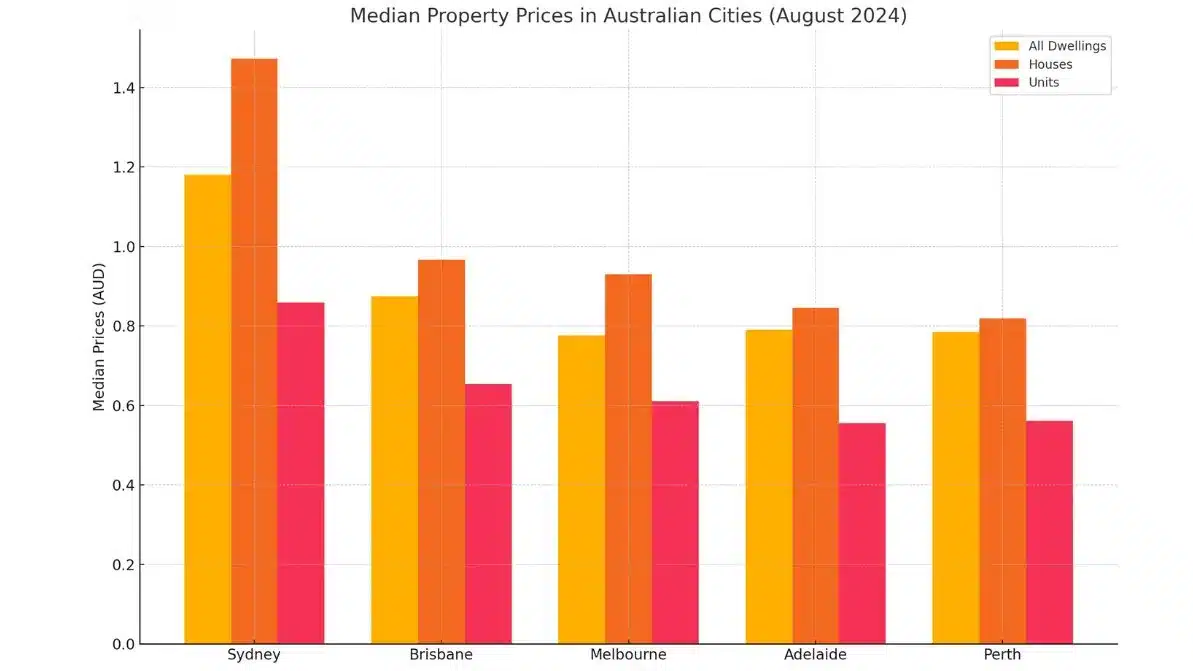Australian property prices August 2024 continue to showcase diverse trends across its major cities, with significant shifts in rankings for median dwelling values, which encompass houses, townhouses, and units. As of August 2024, Brisbane has notably overtaken Melbourne in overall dwelling values, continuing a trend that began in December 2023. Additionally, Brisbane surpassed Melbourne in both house and unit prices in May 2024, underscoring the dynamic nature of the Australian property market.
Median Dwelling Values Across Major Cities
| Ranking | Median Dwelling Prices | Median House Prices | Median Unit Prices |
| 1 | Sydney: $1,180,463 | Sydney: $1,471,892 | Sydney: $859,050 |
| 2 | Brisbane: $875,040 | Canberra: $967,933 | Brisbane: $653,325 |
| 3 | Canberra: $845,875 | Brisbane: $966,382 | Melbourne: $610,652 |
| 4 | Adelaide: $790,789 | Melbourne: $929,715 | Canberra: $579,774 |
| 5 | Perth: $785,250 | Adelaide: $844,963 | Perth: $561,582 |
| 6 | Melbourne: $776,044 | Perth: $818,839 | Adelaide: $555,464 |
Source: CoreLogic
The figures highlight Sydney’s dominance as the most expensive capital city, with a median dwelling value significantly higher than the rest. Meanwhile, Melbourne has fallen to sixth place among major Australian cities in terms of median dwelling values, only slightly ahead of Perth. Brisbane’s ascension above Melbourne marks a significant turning point, as it cements its position as the second most expensive market among the major capitals. This shift is a testament to the evolving Australian property prices August 2024, where regional growth and migration trends significantly impact the overall rankings.
House vs. Unit Prices: A Deeper Analysis
Examining the the Australian Property Prices August 2024 by housing type—houses and units—provides further insights into the factors influencing median values across the cities.
Despite Melbourne’s overall lower median dwelling value, it is important to emphasise that Melbourne’s median house price ($929,715) and median unit price ($610,652) still exceed those of Adelaide and Perth. This demonstrates Melbourne’s resilience in the housing market compared to some of its rivals. However, Brisbane’s robust growth has allowed it to surpass Melbourne in both categories, with a median house price of $966,382 and a median unit price of $653,325 since May 2024. This milestone indicates Brisbane’s ongoing appeal and its ability to attract both local and interstate buyers, reflecting the broader trends in Australian property prices.
The Role of Housing Composition in Melbourne’s Median Values
Melbourne’s lower overall median dwelling value can be largely attributed to the city’s specific housing composition. Around 33% of Melbourne’s homes are units, compared to approximately 16% in Perth and Adelaide. Units generally have lower values than houses, and this higher proportion of units weighs down Melbourne’s overall median dwelling price.
This high concentration of multi-unit dwellings in Melbourne reflects the city’s urban density and planning strategies, which have historically favoured apartment and townhouse developments. Units typically offer more affordable entry points into the market, catering to first-home buyers, investors, and downsizers, but this also has the effect of dragging down the overall median price when compared to cities like Perth and Adelaide, where housing stock is predominantly detached homes. This structural difference plays a significant role in shaping the overall Australian property prices landscape.
When separating house and unit prices, Melbourne continues to outpace Perth and Adelaide, reaffirming the impact of housing composition on median value rankings. This dynamic is a critical factor in understanding Melbourne’s current positioning among Australia’s capital cities. The dominance of unit construction in Melbourne is likely to persist, especially as the city grapples with affordability concerns and urban planning policies that encourage higher-density living.
Brisbane’s Rise: A New Market Contender
Brisbane’s overtaking of Melbourne in median dwelling values began in December 2023, reflecting significant changes driven by factors such as strong interstate migration, robust population growth, and increased demand for housing. By May 2024, Brisbane had also surpassed Melbourne in both house and unit prices, marking a significant milestone in the city’s property market evolution. Brisbane’s dwelling values have increased by 71.5% since August 2019, highlighting its rapid ascension in the national property market hierarchy and its growing influence on Australian property prices.
Several factors have fueled Brisbane’s rise. The city has benefited from a surge in interstate migration, particularly from Melbourne and Sydney, as people seek more affordable housing options and a better lifestyle. The COVID-19 pandemic accelerated these trends, as remote work arrangements and lifestyle changes made Brisbane an attractive alternative to the larger and more expensive cities. The Queensland government’s investments in infrastructure, coupled with the upcoming 2032 Olympic Games, have also played a role in boosting market confidence and property values.
The popularity of Brisbane’s suburbs and surrounding regions has grown, with strong demand for detached houses driving significant price growth. The city’s housing market is characterised by relatively low density compared to Melbourne, with a higher proportion of detached homes and a lower concentration of units. This composition has helped Brisbane maintain a higher overall median price, as the majority of its market consists of more valuable housing types, further influencing Australian property prices.
Sydney: The Dominant Market Leader
Sydney remains at the top of the rankings, with the highest median prices for all dwelling types, houses, and units. The city’s median dwelling value of $1,180,463 reflects its status as Australia’s most expensive property market, driven by strong demand, limited supply, and ongoing affordability challenges. Sydney’s house prices, averaging $1,471,892, are significantly higher than those in any other capital city, highlighting the premium associated with detached homes in Australia’s largest metropolis.
Sydney’s market is also characterised by a high level of unit development, particularly in the inner city and key transport corridors, as the city continues to expand vertically rather than horizontally. Units in Sydney command a premium compared to other cities, with a median price of $859,050, due to the high demand for inner-city living and the limited availability of space. This trend significantly impacts Australian property prices, maintaining Sydney’s position at the forefront.
The Future Outlook
Looking ahead, the Australian property prices are expected to continue experiencing shifts influenced by broader economic factors, such as interest rate changes, migration patterns, and housing supply dynamics. Brisbane’s emergence as a strong competitor to Melbourne underscores the importance of market adaptability and the impact of demographic shifts on property values.
Melbourne, while facing challenges related to housing composition, remains a key player in the national market, with opportunities to rebound as demand for more affordable urban living continues. Sydney’s high prices are likely to persist, driven by its economic significance and ongoing population growth, although affordability pressures will continue to shape buying behaviors and market dynamics.
Conclusion
The Australian Property Prices August 2024 property market data illustrates a shifting landscape where Brisbane has firmly established itself above Melbourne in median dwelling values, house prices, and unit prices. This trend, driven by demographic shifts and housing market dynamics, emphasises the evolving nature of Australia’s capital cities. While Melbourne’s housing composition continues to influence its overall median value, Brisbane’s recent surge highlights its growing appeal as a leading market in Australia. Sydney remains at the top, but the changes across other capitals signal a broader transformation in the Australian property market. The evolving nature of Australian property prices underscores the importance of understanding local market conditions when making property investment decisions in Australia.
Share This Blog On:










